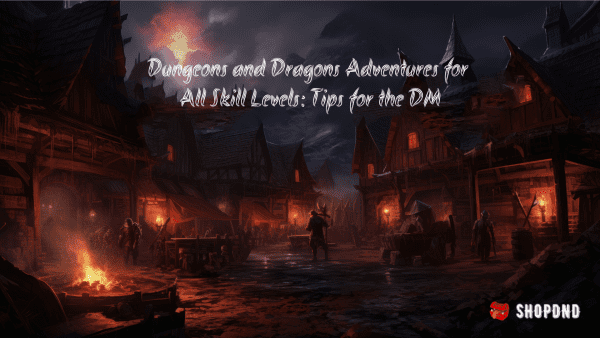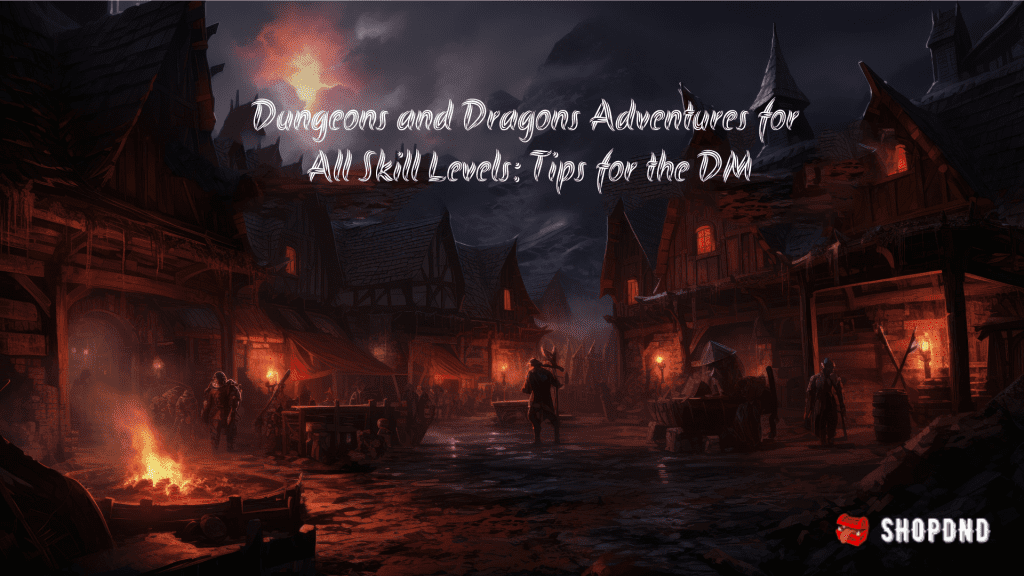
Dungeons and Dragons Adventures for All Skill Levels: Tips for the DM
If you're the Dungeon Master (DM) for your Dungeons and Dragons (D&D) campaign, you hold the keys to an immersive and unforgettable gaming experience. Whether you're a seasoned DM or just starting your journey, this guide is here to help you craft memorable adventures for players of all skill levels. At ShopDnD, we're not only passionate about providing fantastic D&D-themed clothing but also supporting the entire D&D community. Let's dive into the world of Dungeons and Dragons adventures and explore some invaluable DMing tips.
01 Understanding Player Levels
Different Strokes for Different Folks
One of the most crucial aspects of crafting Dungeons and Dragons adventures is understanding the skill levels and preferences of your players. Are they newcomers, casual gamers, or seasoned veterans? Tailoring your Dungeons and Dragons adventures to suit their experience level can make all the difference.
Newcomers might appreciate a straightforward storyline with clear objectives, while seasoned players might relish intricate plots with moral dilemmas and grey areas. Communication with your players about their expectations can be invaluable.
Adapting to Player Levels
Adapting your Dungeons and Dragons adventures to suit the skill level of your players involves a few key considerations:
- Complexity of Story: For newcomers, it's best to start with a simple, linear storyline that gradually introduces them to D&D mechanics. As players gain experience, you can introduce more complex narratives with branching paths and moral dilemmas.
- Combat Difficulty: Adjust the difficulty of combat encounters. New players may need easier battles to learn the rules, while experienced players might crave challenging foes.
- Puzzle and Role-play Elements: Gradually introduce puzzle-solving and role-play elements. Beginners may struggle with intricate puzzles, so start with straightforward challenges and build up to more complex ones.
02 Balancing Encounters
Challenges Made Just Right
Achieving the perfect balance in encounters is an art that every DM must master. Overly easy encounters can lead to boredom, while excessively challenging ones may frustrate your players. Consider the party's composition, abilities, and equipment when designing encounters.
Remember, D&D is not just about combat but also role-playing, problem-solving, and exploration. Variety in encounters keeps the game exciting and engaging.
Tips for Balancing Encounters
Balancing encounters requires a mix of art and science. Here are some tips to help you get it right:
- Use Challenge Ratings: The Monster Manual provides Challenge Ratings (CR) for creatures. These ratings give you a baseline for the difficulty of encounters.
- Monitor Party Resources: Keep track of the party's spell slots, hit points, and other resources during encounters. If they're running low, consider toning down the difficulty of future encounters.
- Adjust on the Fly: Don't be afraid to modify an encounter's difficulty during play. If the battle is too easy, introduce reinforcements or change tactics mid-fight. If it's too tough, have enemies retreat or offer opportunities for diplomacy.
- Vary Encounter Types: Mix combat encounters with social challenges, puzzles, and mysteries. This diversity keeps players engaged and prevents combat fatigue.
03 Creating Engaging Storylines
Weaving Tales of Intrigue
The heart of any Dungeons and Dragons adventures lies in its narrative. Crafting an engaging storyline with compelling characters, mysteries, and plot twists is essential. Keep the story flexible, allowing for player choices to influence its direction.
Crafting Engaging Storylines
Creating a captivating story is both an art and a craft. Here's how you can craft engaging narratives:
- Start with a Hook: Begin your campaign with a hook that grabs players' attention. It could be a tantalising rumour, a mysterious artefact, or a plea for help from an NPC.
- Develop Compelling NPCs: Populate your world with memorable NPCs. Give them motivations, secrets, and quirks. The more depth you provide, the more invested players will become.
- Use Foreshadowing: Drop hints and clues about the overarching plot throughout the campaign. Foreshadowing builds anticipation and encourages players to connect the dots.
- Embrace Player Agency: Allow player choices to influence the story's direction. Be ready to adapt to unexpected decisions and incorporate them into the narrative.
04 Utilising Props and Maps
Visual Aids for Immersion
Enhance immersion by using props and maps. Physical or digital maps can provide a visual representation of the world, making exploration more tangible. Handouts, illustrations, and miniatures can bring key elements of the story to life.
Enhancing Immersion
The use of props and maps can transport your players to the world you've created. Here's how to do it effectively:
- Invest in Quality Maps: High-quality maps add depth to your world. Whether it's a world map, a dungeon layout, or a town plan, invest time or resources into creating visually appealing maps.
- Use Miniatures and Tokens: Miniatures or tokens can represent characters and creatures on the battlefield. They make combat encounters more dynamic and help players visualise positioning.
- Handouts and Illustrations: Provide players with handouts, illustrations, or sketches of important scenes, items, or characters. These visuals can trigger their imagination and immersion.
- Interactive Maps: Digital tools like Roll20 or Fantasy Grounds allow for interactive maps that players can explore. These platforms also support dynamic lighting and fog of war effects.
05 Fostering Player Creativity
Encouraging Player Agency
D&D is a collaborative storytelling experience. Encourage your players to be creative and think outside the box. Embrace their ideas and adapt the story accordingly. Player agency leads to a more dynamic and enjoyable Dungeons and Dragons adventures.
Empowering Player Creativity
Here's how you can empower your players to be more creative during the game:
- Reward Creative Solutions: When players come up with imaginative solutions to challenges, reward them with inspiration points or bonus XP.
- Create Open-Ended Challenges: Present challenges that have multiple solutions, allowing players to choose their approach. This encourages creativity.
- Embrace Character Backstories: Encourage players to create detailed character backstories. Weave elements of their backgrounds into the main plot to make the story more personal.
06 Incorporating Puzzles and Riddles
The Mind-Bending Element
Puzzles and riddles add depth to your Dungeons and Dragons adventures. They challenge players' problem-solving skills and provide a break from combat. Be prepared to offer hints if your players get stuck, ensuring that puzzles are engaging, not frustrating.
Designing Engaging Puzzles
Designing puzzles requires careful consideration to keep players engaged. Here are some guidelines:
- Theme and Integration: Ensure puzzles fit seamlessly into the story and the setting. A riddle in an ancient tomb or a lock puzzle on a treasure chest makes sense within the context.
- Multiple Approaches: Allow for different approaches to solving puzzles. Some players may excel at logic puzzles, while others prefer physical challenges.
- Hint System: Have a hint system in place. Players can earn hints by making successful Intelligence checks or finding clues in the environment.
- Avoid Stalemates: If players are stuck, provide a way for them to bypass the puzzle, such as finding an alternative route or seeking help from an NPC.
07 Managing NPCs Effectively
Bringing Characters to Life
Non-player characters (NPCs) play a significant role in Dungeons and Dragons adventures. Give them distinct personalities, motives, and quirks. Engaging NPCs can evoke emotions, build alliances, or create adversaries, enriching the storytelling experience.
Creating Memorable NPCs
Creating memorable NPCs requires attention to detail and a dash of creativity:
- Backstories and Motivations: Develop backstories and motivations for NPCs. Understanding their goals and history helps you role-play them consistently.
- Distinctive Traits: Give NPCs distinctive traits, such as unique accents, voices, or mannerisms. This helps players differentiate between characters.
- Evolve with the Story: Allow NPCs to evolve as the story progresses. They can form alliances, change allegiances, or undergo personal growth.
- Dynamic Reactions: Make NPCs react to player actions and choices. This dynamic interaction adds depth to the game world.
08 Handling Player Mistakes
Rolling with the Punches
Mistakes happen, and that's part of the fun. As a DM, be flexible and adaptable. Embrace unexpected player decisions, and use them to steer the story in exciting new directions. Sometimes, the best moments in D&D emerge from unpredictability.
Adapting to Player Choices
Adapting to player choices, even when they lead to unexpected outcomes, is essential for a dynamic game:
- Embrace Surprises: Embrace player creativity and unexpected decisions. These moments often result in memorable and entertaining stories.
- Improvise: Be prepared to improvise. If players take a path you hadn't anticipated, think on your feet and adapt the storyline accordingly.
- Balance Consequences: While player agency is essential, ensure that there are consequences for their actions, both positive and negative. This makes the world feel responsive and immersive.
09 Seeking Player Feedback
Improvement through Communication
After each session or Dungeons and Dragons adventures, solicit feedback from your players. What did they enjoy? What could be improved? Honest communication fosters a better gaming experience. Adjust your DMing style based on their input.
Encouraging Feedback
Creating a culture of feedback enhances the gaming experience for everyone involved:
- Feedback Sessions: After a major story arc or campaign, schedule a feedback session where players can openly discuss their experiences.
- Anonymous Surveys: Use anonymous surveys to gather feedback on specific aspects of the game, such as storytelling, encounter balance, or pacing.
- Implement Suggestions: Act on constructive feedback. If multiple players highlight the same issue, consider addressing it in future sessions.
- Appreciate Feedback: Show appreciation for feedback, even if it's critical. It demonstrates your commitment to improving the gaming experience.
10 Conclusion: Elevate Your DMing Skills
In the world of Dungeons and Dragons adventures, the Dungeon Master plays a pivotal role in creating memorable experiences. By understanding your players, balancing encounters, crafting engaging storylines, and fostering creativity, you can elevate your DMing skills and provide unforgettable Dungeons and Dragons adventures for players of all skill levels.
At ShopDnD, we're not just about D&D-themed clothing; we're here to support the D&D community in all aspects of the game. If you have any questions or want to connect with us on social media, don't hesitate to contact us or follow us on Facebook, TikTok and Instagram. If you are looking for D&D gift ideas or looking to enhance your gaming experience with D&D clothing, such as D&D hoodies, explore our store for unique and stylish options. If you have any questions about our store, size guide, delivery info, or need assistance with D&D-related queries, don't hesitate to contact us. Together, we can make every Dungeons and Dragons adventures a truly epic experience.


